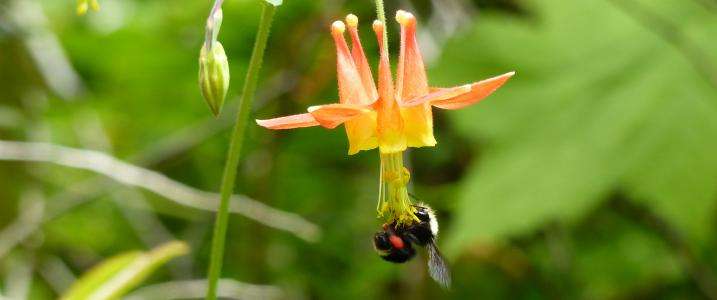
In case you haven’t heard, wild bees around the world aren’t doing that great. If you like to eat food, or enjoy having trees and other plants in your world, that’s a big cause for concern.
But, it turns out, according to this article from PHYS.org, that wild bees thrive after moderate and severe wildfires:
“Early results from a two-year study in southern Oregon suggest that moderate and severe forest fires create conditions that lead to greater abundance and diversity of wild bees. Because Oregon’s more than 500 species of native bees are important pollinators of wild plants and crops, the study suggests that fires may promote bee populations that in turn may influence agricultural productivity and overall floral diversity.”
In 2016, scientists began trapping bees at 43 sites in forests burned by the 2013 Douglas Complex fire north of Grants Pass. The sites ranged from places where fire severity was low—flames were confined to low-growing vegetation and failed to reach the canopy—to places where severity was moderate and high.
“In low severity spots, if you weren’t looking for the markers of fire, you wouldn’t know that it had burned,” said Sara M. Galbraith, a post-doctoral researcher in the College of Forestry at Oregon State University. “The canopy is completely closed, and the trees are usually older. There isn’t a lot of evidence of fire except for some blackened areas on some of the tree trunks.
“And then, when you go to some of the high-severity fire sites, it’s a completely open canopy. There are a lot of flowering plants in the understory because the light limitation is gone. It just looks completely different,” she added.
In a study led by Jim Rivers, OSU forest wildlife ecologist, Galbraith and a team of field researchers collected bees with blue-vane traps, which attract the insects by reflecting ultra-violet light. “The bees basically think it’s a huge flower,” said Galbraith. “Once they get inside the trap, they are unable to fly out because of the shape of the entrance.”
In addition, researchers recorded the characteristics of each site, such as the types of plants, the degree of forest cover and whether or not logging had taken place after the fire.
Such studies are important, Galbraith said, because the early stages of forest development – what researchers call early seral forests—have become less common. “This research adds to the evidence that there is high biodiversity in early seral forests relative to older stands, and moving forward, this could have an impact on services like pollination in the landscape overall. Without this fundamental information, we can’t be sure of the best management actions to conserve pollinator populations within managed forests.”
This is interesting and important research, but the findings aren’t at all surprising to foresters. It is also well known that “seral forests—have become less common” and that “there is high biodiversity in early seral forests relative to older stands.” I’m glad the researchers acknowledge these facts. I have not read the study, but I wonder if the researchers looked at how bees respond to other forms of disturbance, such as prescribed fire and timber harvesting. In any case, the research serves as support for the “ecological forestry” proposed by Jerry Franklin and Norm Johnson, where variable retention harvesting is used to ease the deficit in in early seral forests, which we’ve discussed here several times, such as https://forestpolicypub.com/2014/07/29/ecological-forestry-as-regional-model/. This kind of management isn’t appropriate everywhere, but I think it has great potential on federal lands in the PNW. The key to its success is convincing the those who are opposed to all or most harvesting that “ecological forestry” would be quite beneficial, over all.